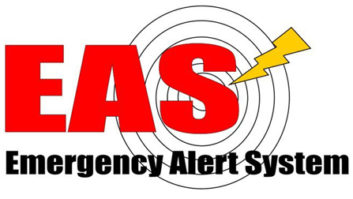
Steve Baker, program director of WQLK(FM) in Richmond, Ind., checks his Sage EAS box.WASHINGTON — New rules for Emergency Alert System participants crafted by the FCC are meant to maximize the overall effectiveness of the U.S. public warning system. We reported on this story earlier, now let’s take a closer look.
The commission in June released its Sixth Report and Order continuing a long process to improve EAS and bring consistency to the alerting space following the first national EAS test in 2011. Among the issues settled by the FCC is a new national location code of “six zeroes” (000000) and a requirement for broadcasters to file future national test EAS data electronically.
The first nationwide test used “Washington, DC” as a location code; a number of encoders/decoders failed to recognize the code as being relevant to their areas. The new “six zeroes” will pertain to every state and U.S. territory, the FCC said in its report and order.
In addition, broadcasters will now need to configure their EAS gear to process a National Periodic Test event code for future nationwide tests of the system. Broadcasters must comply within 12 months of the rules’ effective date, July 30.
Most of the adopted changes had been recommended by the FCC’s Communications Security, Reliability and Interoperability Council, which consists of device manufacturers, broadcasters, public safety officials and others. There are some CSRIC recommendations on which the FCC has yet to act, several observers said.
NEXT TEST
EAS experts have been pushing for a second national EAS test in 2015, but FEMA said recently it will not schedule a national EAS test date until after the broadcaster compliance date. It now appears the soonest a second test could be scheduled would be the second half of 2016.
The Federal Emergency Management Agency is responsible for the initial transmission of presidential alerts and overall administration of the system; the FCC says its own role is to adopt, administer and enforce EAS.
FEMA continues to offer support to state broadcast associations wishing to coordinate statewide EAS testing using NPT messages. Thus far, successful tests have been conducted in West Virginia, Michigan, Ohio, Kentucky and Tennessee, according to FEMA.
“Our next regional test is scheduled to take place on Sept. 16 in conjunction with the state broadcast associations of Maine, Vermont, New Hampshire, Massachusetts, Connecticut and Rhode Island,” said Al Kenyon, Integrated Public Alert and Warning System national test technical lead. “While preparing for these regional tests we’ve had an opportunity to renew the dialog between broadcasters and state emergency management officials about how EAS can be better used to serve the whole community.”
This regional testing, performed ahead of the compliance period specified in the rulemaking, is designed to be conducted in a no-risk environment for participants, Kenyon said.
EAS observers asked by Radio World to participate in this story shared a range of opinions on how successful new EAS rules will be and how much of an impact the new rules will have on broadcasters.
Adrienne Abbott, Nevada EAS chair, described the latest R&O as “focused on the next national EAS test” with a little side commentary on other issues, like the visual text produced by EAS equipment.
Abbott said she expects most broadcasters will already have the EAS equipment in place needed to interpret the new codes successfully.
“On the surface, it appears that there are no significant changes that would require broadcasters to purchase new equipment. The changes can be easily made by station staff. Engineers in Nevada say they’ve been able to update their equipment with a minimum of fuss,” Abbott said.
UPDATES
Ed Czarnecki, senior director of strategy and global government affairs for the Digital Alert Systems division of equipment manufacturer Monroe Electronics, said customers will need to modify a few settings on their equipment to comply with the FCC order.
“We don’t see many significant changes for radio stations using DASDEC equipment. Radio stations and EAS manufacturers have 12 months to meet the requirements of the order, which include adjusting how both the NPT and EAN react to the new national geocode, as well as existing local FIPS codes.”
Czarnecki said DASDEC currently supports the “six zeroes” location code, as well as immediate auto-forwarding of the NPT message for transmission.
“However, to further streamline functions for DASDEC users, and to accommodate the change in allowing EANs to target specific state/local FIPS codes, we are likely to issue an additional software update soon. We will contact DASDEC users when this software update is available.”
The countdown clocks to initiate updates begin 30 days after the R&O is published in the Federal Register, EAS experts said.
“Many broadcasters will need to make some sort of change to their settings to add the NPT alert, add the ‘000000’ code, or both,” said Harold Price, president of Sage Alerting Systems.
Sage CAP/EAS ENDEC users (Model 3644) will upload a firmware update, Price said. “By this time, [our customers] have been through the process of updating firmware and settings. This will be no different. The FCC has allowed plenty of time for everyone to make the required changes.”
Users of some older-model Sage ENDEC models will need replacements, Price said. The FCC mentions in a footnote in the R&O that users of non-CAP model 1822 will need to replace their hardware.
“Model 1822 will not be updated since support for that product ended in 2011. Users of that equipment will need to acquire new hardware. We don’t have exact numbers, but we feel that only a small number of stations remain on the old equipment,” Price said.
A significant development since 2011 has been the addition of alerting using the Internet-based Common Alerting Protocol. CAP was not included in the first national test, since TV and radio stations were not required to have CAP-compliant EAS equipment until June 30, 2012.
COMING: NEW EAS FORMS TO FILL OUT
For broadcasters, interacting with FCC databases has sometimes been a source of frustration. But the commission is hopeful that a planned system for stations report the outcome of nationwide EAS tests will involve a minimum of filing hassle, and help it create an EAS “Mapbook” to illustrate how alerts are propagated.
The FCC used a temporary electronic filing system to gather data in the first nationwide test four years ago. An advisory council subsequently recommended that it also develop a federal government database to contain EAS monitoring assignments.
So when the commission issued its R&O to strengthen EAS, one of its actions was to require that participants file future test data via a planned Electronic Test Report System that would help accomplish both objectives.
The commission plans three forms for EAS participants (such as radio and TV stations) to fill out. Participants will have to update information yearly and as required by updates or waivers to State EAS Plans.
The FCC also plans to integrate information that it obtains into State EAS Plans, consolidating those into an EAS Mapbook. Its goal is a centralized database containing all EAS monitoring assignments and alert distribution pathways, “enabling new analyses of alert distribution at the national, state and local levels.” The new system is supposed to be able to create maps that indicate the propagation of an EAN throughout the EAS architecture.
NEW ETRS
The FCC is creating a new Electronic Test Reporting System and is mandating that all EAS participants use it to file test results electronically with the FCC immediately following any nationwide EAS test (see box). Broadcasters had identified a number of problems with the previous electronic filing system.
Not all EAS stakeholders are satisfied with the commission’s latest R&O. At least one EAS expert says the FCC was late in acting to fix EAS and blames the commission for some in the EAS community becoming disenchanted.
Richard Rudman, a founding member of the Broadcast Warning Working Group, a public-private partnership of some of the country’s top warning experts, called FCC action on EAS “much, much too slow.”
“The palpable effect has been to lose the hearts and minds of many of us who had high hopes for major improvements to the county’s public warning system by the EAS. The R&O does not begin to address all these inconsistencies and errors,” said Rudman, who is also vice chair of California’s EAS SECC.
Rudman also feels the FCC is too focused on national level EAS compliance and monitoring in the latest R&O: “We have to remember that most emergencies are local.”
Nevada’s Abbott, also a member of BWWG, is concerned about a “rather cavalier” attitude that the FCC is taking toward the EAS State Emergency Communications chairs and committee members.
“Apparently they haven’t learned yet that we are not the State Emergency Coordination Committee. The SECC’s are left out of the electronic reporting process,” Abbott said. “The FCC Mapbook thing is an entirely different discussion.”
(At press time, BWWG filed with the FCC a list of recommended EAS “next steps.” We’ll report on those next issue.)
Also, the FCC is directing its Public Safety and Homeland Security Bureau to host a workshop in collaboration with FEMA to address the improvement of alert accessibility, according to the report and order.
The workshop, expected to take place yet this summer, also will look at ways to expand the use of EAS by emergency managers at the state and local levels.







